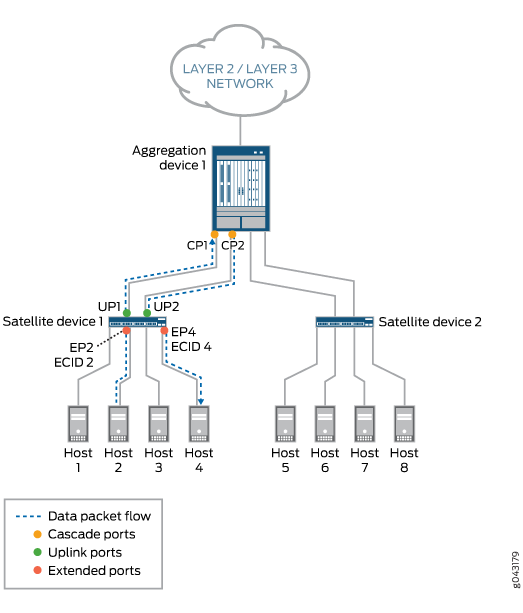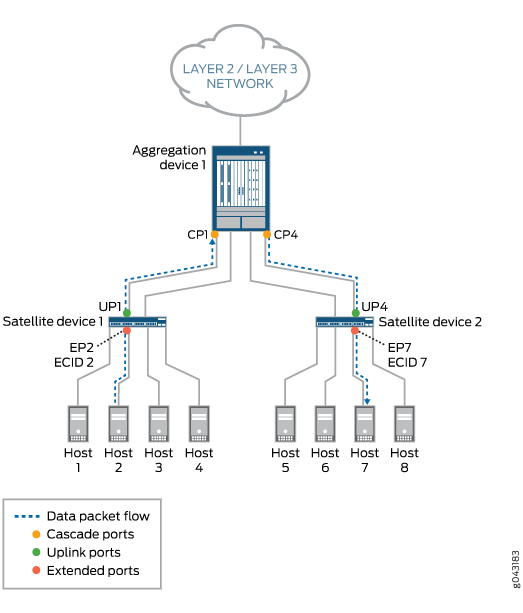Understanding the Flow of Data Packets in a Junos Fusion Topology
All Ethernet data packets that are exchanged between aggregation devices and satellite devices in a Junos Fusion topology include an E-channel tag (ETAG) header that carries an E-channel identifier (ECID) value. The ECID value, which is assigned by the aggregation device, identifies the source or destination extended port on one of the connected satellite devices.
In a sample Junos Fusion topology, where an aggregation device is connected to two satellite devices, the following Layer 2 unicast data packet flow scenarios can occur:
Scenario 1—A host on one satellite device sends a packet to another host on the same satellite device. For example, Host 2 sends a unicast packet to Host 4. Both hosts are connected to Satellite device 1. (See Figure 1.)
Scenario 2—A host on one satellite device sends a packet to another host on the other satellite device. For example, Host 2, which is connected to Satellite device 1, sends a unicast packet to Host 7, which is connected to Satellite device 2. (See Figure 2.).


In scenario 1, where Host 2 sends a unicast data packet to Host 4, the following events occur:
Only the events that are performed by Junos Fusion components are listed. Events handled by components that are not specific to the Junos Fusion topology are excluded.
Extended port EP2 on Satellite device 1 receives the packet from Host 2.
Satellite device 1 inserts an ETAG header in the packet. The ETAG header carries the ECID value (ECID 2), which is assigned by Aggregation device 1 to extended port EP2.
On Satellite device 1, two uplink ports (UP1 and UP2) are connected to Aggregation device 1. As a result, traffic between the devices can be load-balanced. In this case, uplink port UP1 is chosen to forward the packet to cascade port CP1 on Aggregation device 1.
On receiving the packet, Aggregation device 1 extracts the ECID value (ECID 2) from the ETAG header of the packet and learns that the packet is from extended port EP2 on Satellite device 1. Aggregation device 1 then removes the ETAG header from the packet.
Aggregation device 1 performs a lookup for Host 4. The result of the lookup is extended port EP4 on Satellite device 1.
On Aggregation device 1, two cascade ports (CP1 and CP2) are connected to Satellite device 1. As a result, traffic between the devices can be load-balanced. In this case, cascade port CP2 is chosen to forward the packet to uplink port UP2 on Satellite device 1.
The packet is forwarded to cascade port CP2, where a new ETAG header and ECID value (ECID 4), which is assigned by Aggregation device 1 to extended port EP4, is added.
The packet is received by uplink port UP2 on Satellite device 1.
Satellite device 1 extracts the ECID value (ECID 4) from the ETAG header of the packet, then maps ECID 4 to extended port EP4.
Host 4 receives the packet from extended port EP4.
In scenario 2, where Host 2 sends a unicast data packet to Host 7, the events that occur are the same as for scenario 1 except for the following:
Event 5—Aggregation device 1 performs a lookup for Host 7. The result of the lookup is extended port EP7 on Satellite device 2.
Event 6—On Aggregation device 1, two cascade ports (CP3 and CP4) are connected to Satellite device 2. As a result, traffic between the devices can be load-balanced. In this case, cascade port CP4 is chosen to forward the packet to uplink port UP4 on Satellite device 2.
Event 7—The packet is forwarded to cascade port CP4, where a new ETAG header and ECID value (ECID 7), which is assigned by Aggregation device 1 to extended port EP7, is added.
Event 8—The packet is received by uplink port UP4 on Satellite device 2.
Event 9—Satellite device 2 extracts the ECID value (ECID 7) from the ETAG header of the packet, and then maps ECID 7 to extended port EP7.
Event 10—Host 7 receives the packet from extended port EP7.
